The Cambridge History of Japan, Vol. 3: Medieval Japan
Подождите немного. Документ загружается.

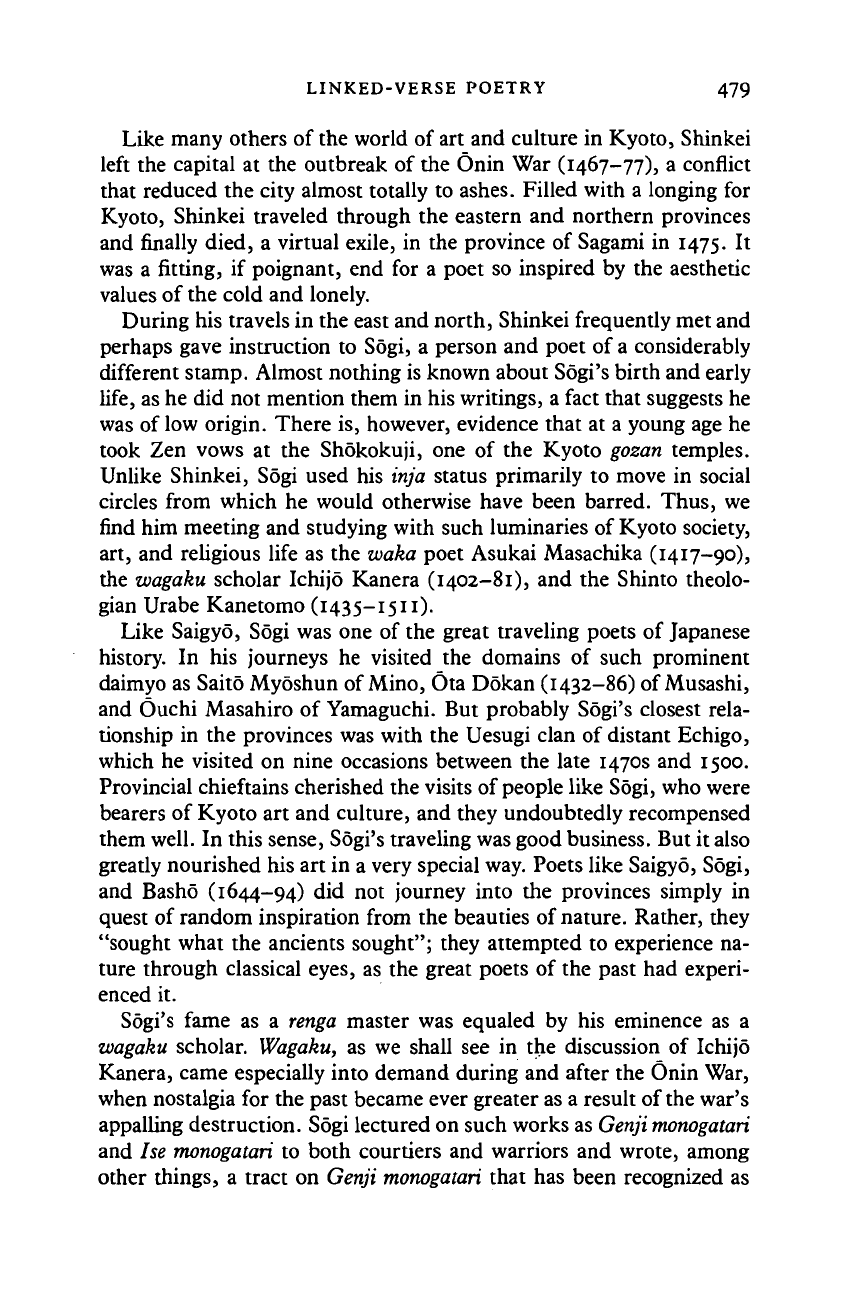
LINKED-VERSE POETRY 479
Like many others of the world of art and culture in Kyoto, Shinkei
left the capital at the outbreak of the Onin War (1467-77), a conflict
that reduced the city almost totally to ashes. Filled with a longing for
Kyoto, Shinkei traveled through the eastern and northern provinces
and finally died, a virtual exile, in the province of Sagami in 1475. It
was a fitting, if poignant, end for a poet so inspired by the aesthetic
values of the cold and lonely.
During his travels in the east and north, Shinkei frequently met and
perhaps gave instruction to Sogi, a person and poet of a considerably
different stamp. Almost nothing is known about Sogi's birth and early
life,
as he did not mention them in his writings, a fact that suggests he
was of low origin. There is, however, evidence that at a young age he
took Zen vows at the Shokokuji, one of the Kyoto gozan temples.
Unlike Shinkei, Sogi used his inja status primarily to move in social
circles from which he would otherwise have been barred. Thus, we
find him meeting and studying with such luminaries of Kyoto society,
art, and religious life as the waka poet Asukai Masachika (1417-90),
the wagaku scholar Ichijo Kanera (1402-81), and the Shinto theolo-
gian Urabe Kanetomo (1435-1511).
Like Saigyo, Sogi was one of the great traveling poets of Japanese
history. In his journeys he visited the domains of such prominent
daimyo as Saito Myoshun of Mino, Ota Dokan (1432-86) of Musashi,
and Ouchi Masahiro of Yamaguchi. But probably Sogi's closest rela-
tionship in the provinces was with the Uesugi clan of distant Echigo,
which he visited on nine occasions between the late 1470s and 1500.
Provincial chieftains cherished the visits of people like Sogi, who were
bearers of Kyoto art and culture, and they undoubtedly recompensed
them well. In this sense, Sogi's traveling was good business. But it also
greatly nourished his art in a very special way. Poets like Saigyo, Sogi,
and Basho (1644-94) did not journey into the provinces simply in
quest of random inspiration from the beauties of nature. Rather, they
"sought what the ancients sought"; they attempted to experience na-
ture through classical eyes, as the great poets of the past had experi-
enced it.
Sogi's fame as a renga master was equaled by his eminence as a
wagaku scholar. Wagaku, as we shall see in the discussion of Ichijo
Kanera, came especially into demand during and after the Onin War,
when nostalgia for the past became ever greater as a result of the war's
appalling destruction. Sogi lectured on such works as Genji
monogatari
and he monogatari to both courtiers and warriors and wrote, among
other things, a tract on Genji
monogatari
that has been recognized as
Cambridge Histories Online © Cambridge University Press, 2008
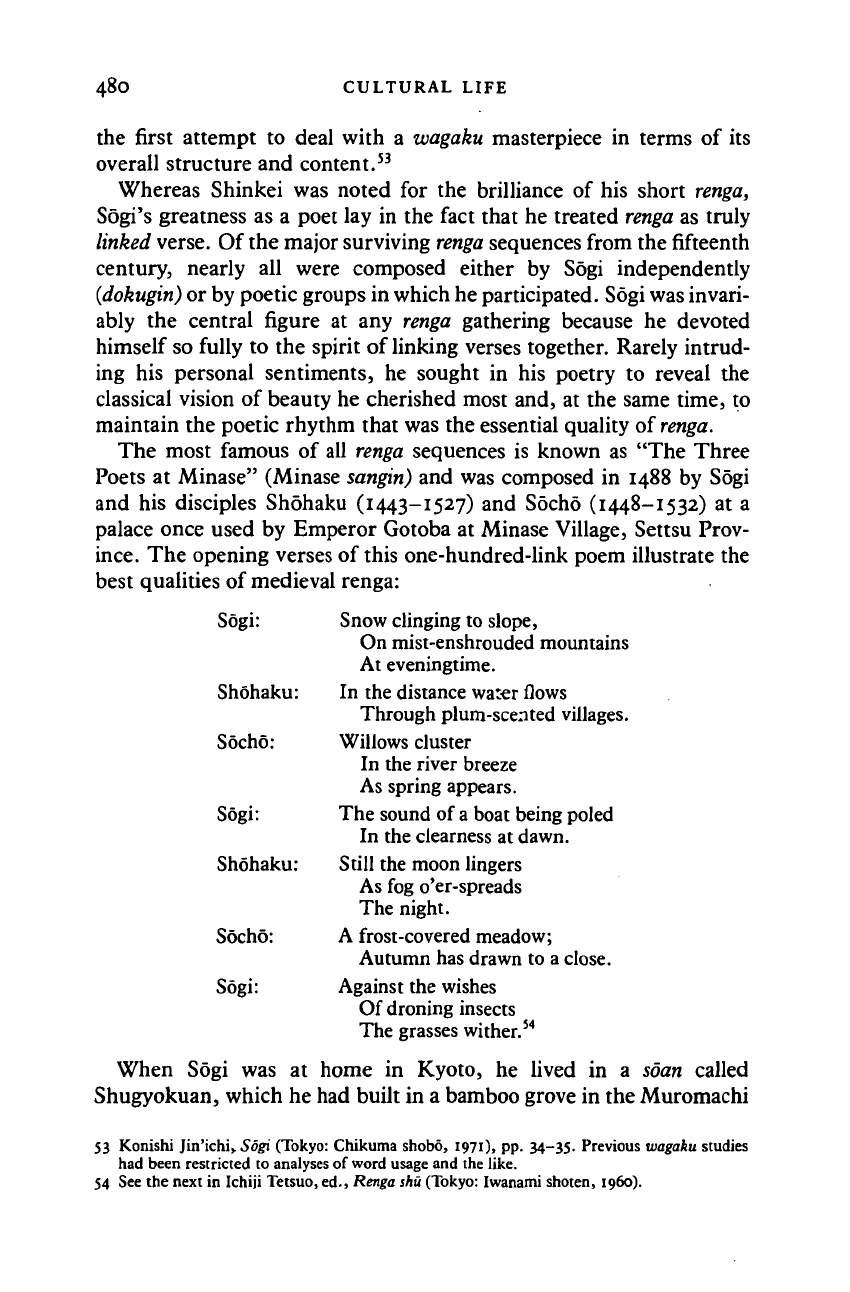
480 CULTURAL LIFE
the first attempt to deal with a wagaku masterpiece in terms of its
overall structure and content.
53
Whereas Shinkei was noted for the brilliance of his short renga,
Sogi's greatness as a poet lay in the fact that he treated renga as truly
linked verse. Of the major surviving
renga
sequences from the fifteenth
century, nearly all were composed either by Sogi independently
(dokugin) or by poetic groups in which he participated. Sogi was invari-
ably the central figure at any renga gathering because he devoted
himself so fully to the spirit of linking verses together. Rarely intrud-
ing his personal sentiments, he sought in his poetry to reveal the
classical vision of beauty he cherished most and, at the same time, to
maintain the poetic rhythm that was the essential quality of
renga.
The most famous of all renga sequences is known as "The Three
Poets at Minase" (Minase sangin) and was composed in 1488 by Sogi
and his disciples Shohaku (1443-1527) and Socho (1448-15 32) at a
palace once used by Emperor Gotoba at Minase Village, Settsu Prov-
ince.
The opening verses of this one-hundred-link poem illustrate the
best qualities of medieval renga:
Sogi: Snow clinging to slope,
On mist-enshrouded mountains
At eveningtime.
Shohaku: In the distance water flows
Through plum-scented villages.
Socho: Willows cluster
In the river breeze
As spring appears.
Sogi: The sound of
a
boat being poled
In the clearness at dawn.
Shohaku: Still the moon lingers
As fog o'er-spreads
The night.
Socho: A frost-covered meadow;
Autumn has drawn to a close.
Sogi: Against the wishes
Of droning insects
The grasses wither.
54
When Sogi was at home in Kyoto, he lived in a soan called
Shugyokuan, which he had built in a bamboo grove in the Muromachi
53 Konishi Jin'ichi* Sogi (Tokyo: Chikuma shobo, 1971), pp. 34-35. Previous wagaku studies
had been restricted to analyses of word usage and the like.
54 See the next in Ichiji Tetsuo, ed., Renga
shu
(Tokyo: Iwanami shoten, i960).
Cambridge Histories Online © Cambridge University Press, 2008
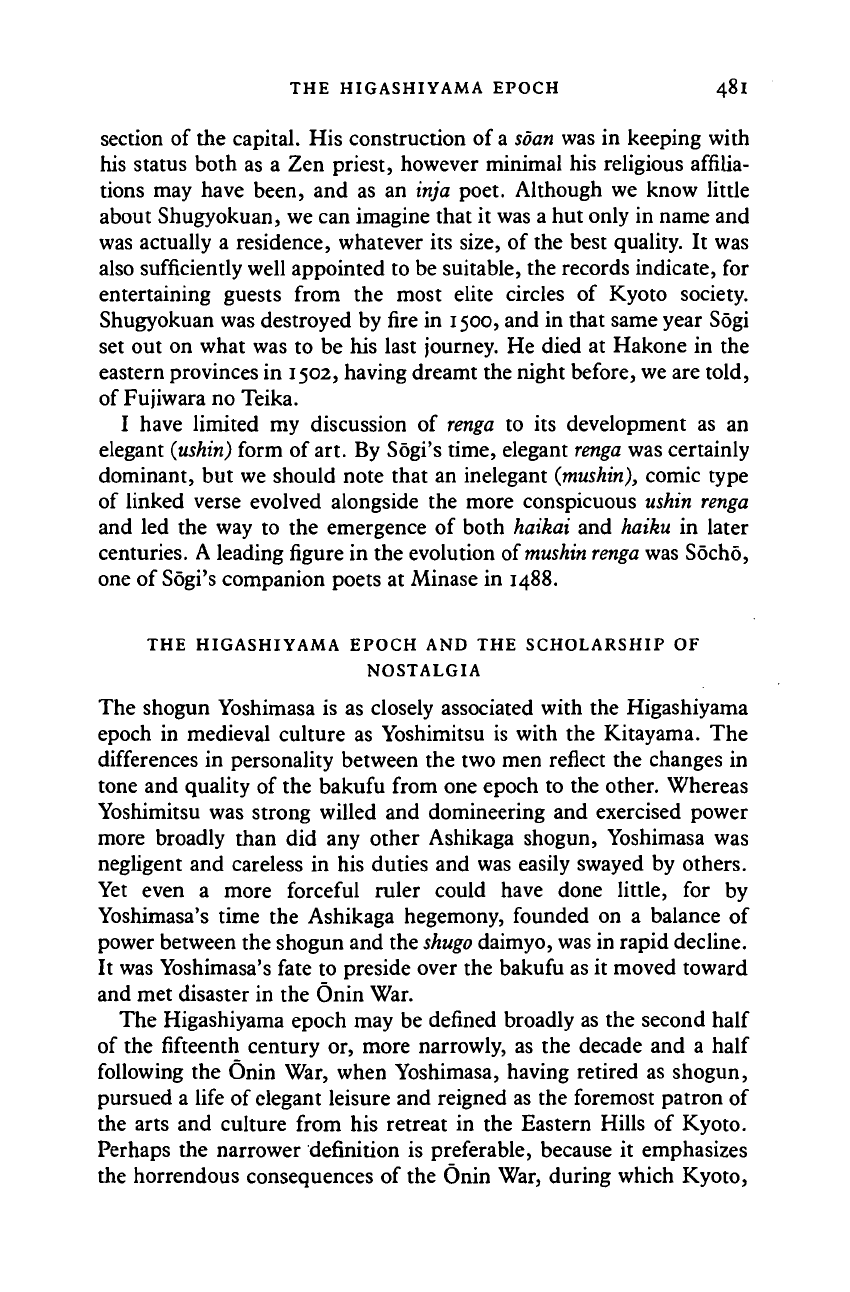
THE HIGASHIYAMA EPOCH 481
section of the capital. His construction of a soan was in keeping with
his status both as a Zen priest, however minimal his religious affilia-
tions may have been, and as an inja poet. Although we know little
about Shugyokuan, we can imagine that it was a hut only in name and
was actually a residence, whatever its size, of the best quality. It was
also sufficiently well appointed to be suitable, the records indicate, for
entertaining guests from the most elite circles of Kyoto society.
Shugyokuan was destroyed by fire in 1500, and in that same year Sogi
set out on what was to be his last journey. He died at Hakone in the
eastern provinces in 1502, having dreamt the night before, we are told,
of Fujiwara no Teika.
I have limited my discussion of renga to its development as an
elegant (ushin) form of art. By Sogi's time, elegant
renga
was certainly
dominant, but we should note that an inelegant (mushin), comic type
of linked verse evolved alongside the more conspicuous ushin renga
and led the way to the emergence of both haikai and haiku in later
centuries. A leading figure in the evolution of
mushin renga
was Socho,
one of Sogi's companion poets at Minase in 1488.
THE HIGASHIYAMA EPOCH AND THE SCHOLARSHIP OF
NOSTALGIA
The shogun Yoshimasa is as closely associated with the Higashiyama
epoch in medieval culture as Yoshimitsu is with the Kitayama. The
differences in personality between the two men reflect the changes in
tone and quality of the bakufu from one epoch to the other. Whereas
Yoshimitsu was strong willed and domineering and exercised power
more broadly than did any other Ashikaga shogun, Yoshimasa was
negligent and careless in his duties and was easily swayed by others.
Yet even a more forceful ruler could have done little, for by
Yoshimasa's time the Ashikaga hegemony, founded on a balance of
power between the shogun and the
shugo
daimyo, was in rapid decline.
It was Yoshimasa's fate to preside over the bakufu as it moved toward
and met disaster in the Onin War.
The Higashiyama epoch may be defined broadly as the second half
of the fifteenth century or, more narrowly, as the decade and a half
following the Onin War, when Yoshimasa, having retired as shogun,
pursued a life of elegant leisure and reigned as the foremost patron of
the arts and culture from his retreat in the Eastern Hills of Kyoto.
Perhaps the narrower definition is preferable, because it emphasizes
the horrendous consequences of the Onin War, during which Kyoto,
Cambridge Histories Online © Cambridge University Press, 2008
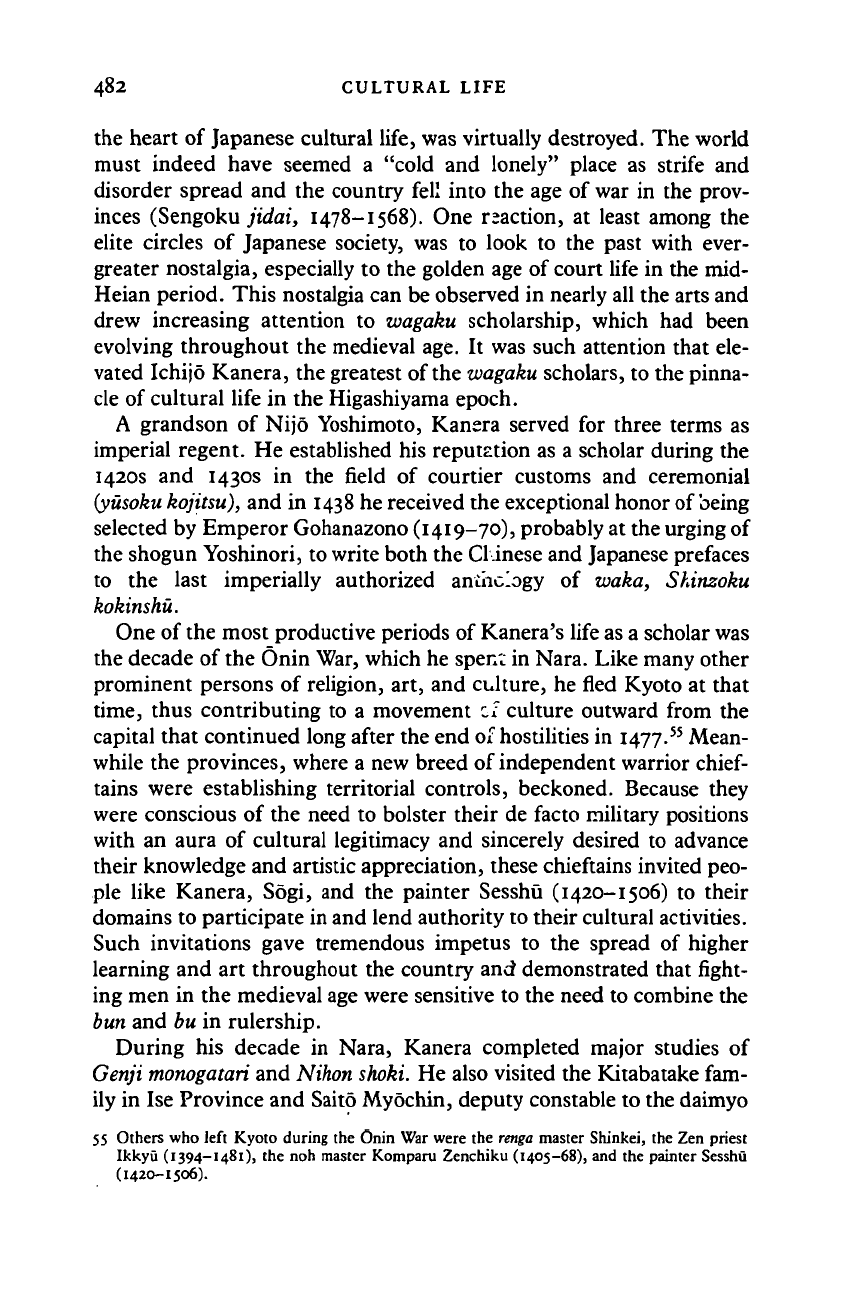
482 CULTURAL LIFE
the heart of Japanese cultural life, was virtually destroyed. The world
must indeed have seemed
a
"cold
and
lonely" place
as
strife and
disorder spread and the country fell into the age of war in the prov-
inces (Sengoku jidai, 1478-1568). One faction,
at
least among the
elite circles
of
Japanese society, was
to
look
to
the past with ever-
greater nostalgia, especially to the golden age of court life in the mid-
Heian period. This nostalgia can be observed in nearly all the arts and
drew increasing attention
to
wagaku scholarship, which
had
been
evolving throughout the medieval age.
It
was such attention that ele-
vated Ichijo Kanera, the greatest of the
wagaku
scholars, to the pinna-
cle of cultural life in the Higashiyama epoch.
A grandson
of
Nijo Yoshimoto, Kanera served
for
three terms
as
imperial regent. He established his reputetion as a scholar during the
1420s
and
1430s
in the
field
of
courtier customs
and
ceremonial
(yusoku
kojitsu),
and in 1438 he received the exceptional honor ofbeing
selected by Emperor Gohanazono (1419-70), probably at the urging of
the shogun Yoshinori, to write both the Chinese and Japanese prefaces
to
the
last imperially authorized anthology
of
waka, Shinzoku
kokinshu.
One of the most productive periods of Kanera's life as a scholar was
the decade of the Onin War, which he spent in Nara. Like many other
prominent persons of religion, art, and culture, he fled Kyoto at that
time,
thus contributing to
a
movement
cf
culture outward from the
capital that continued long after the end of hostilities in 1477.
55
Mean-
while the provinces, where a new breed of independent warrior
chief-
tains were establishing territorial controls, beckoned. Because they
were conscious of the need to bolster their de facto military positions
with
an
aura
of
cultural legitimacy and sincerely desired
to
advance
their knowledge and artistic appreciation, these chieftains invited peo-
ple like Kanera, Sogi, and the painter Sesshu (1420-1506)
to
their
domains to participate in and lend authority to their cultural activities.
Such invitations gave tremendous impetus
to the
spread
of
higher
learning and art throughout the country and demonstrated that fight-
ing men in the medieval age were sensitive to the need to combine the
bun
and bu in rulership.
During
his
decade
in
Nara, Kanera completed major studies
of
Genji monogatari
and Nihon
shoki.
He also visited the Kitabatake fam-
ily in Ise Province and Saito Myochin, deputy constable to the daimyo
55 Others who left Kyoto during the Onin War were the renga master Shinkei, the Zen priest
Ikkyu (1394-1481), the noh master Komparu Zenchiku (1405-68), and the painter Sesshu
(1420-1506).
Cambridge Histories Online © Cambridge University Press, 2008
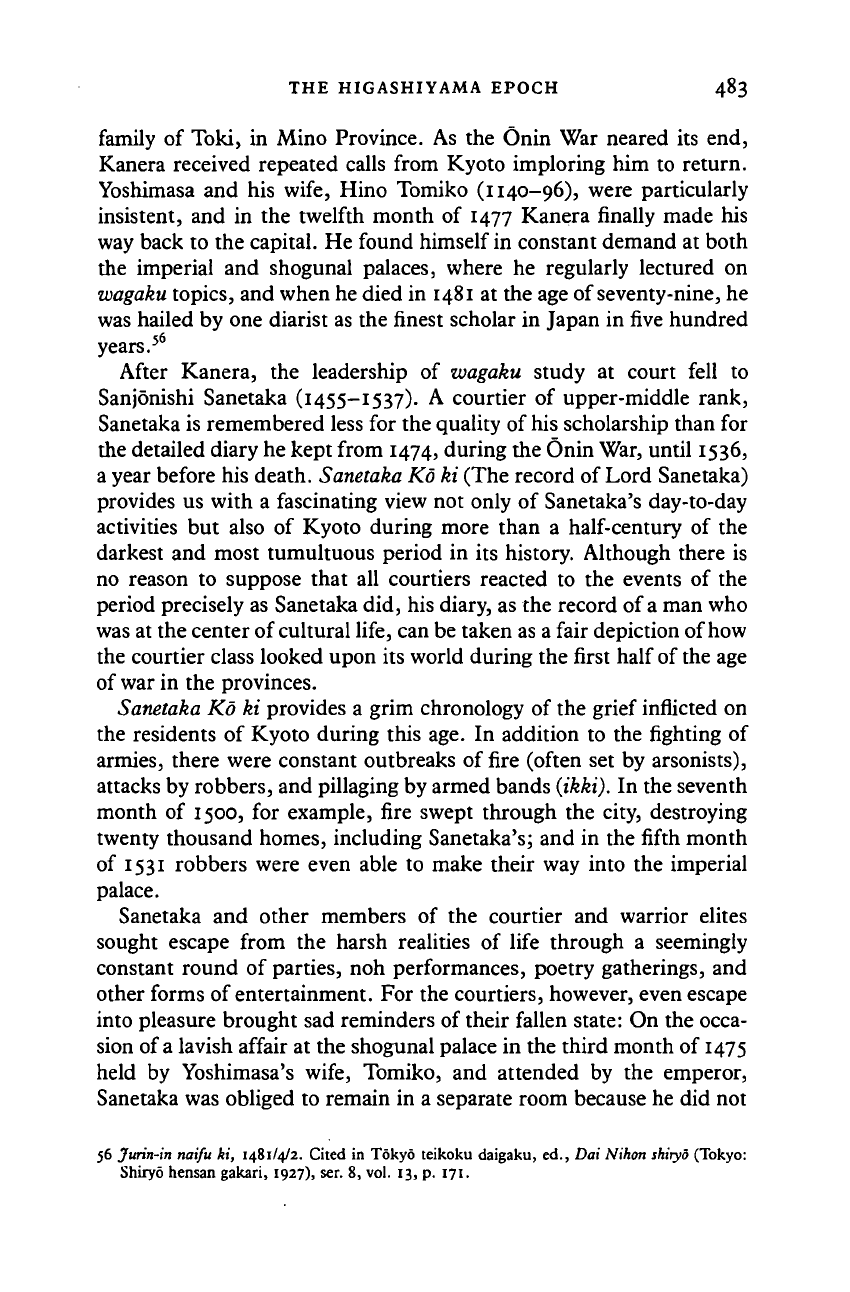
THE HIGASHIYAMA EPOCH 483
family of Toki, in Mino Province. As the Onin War neared its end,
Kanera received repeated calls from Kyoto imploring him to return.
Yoshimasa and his wife, Hino Tomiko (1140-96), were particularly
insistent, and in the twelfth month of 1477 Kanera finally made his
way back to the capital. He found himself
in
constant demand at both
the imperial and shogunal palaces, where he regularly lectured on
wagaku
topics, and when he died in
1481
at the age of
seventy-nine,
he
was hailed by one diarist as the finest scholar in Japan in five hundred
years.
56
After Kanera, the leadership of wagaku study at court fell to
Sanjonishi Sanetaka (1455-1537). A courtier of upper-middle rank,
Sanetaka is remembered less for the quality of
his
scholarship than for
the detailed diary he kept from 1474, during the Onin War, until 1536,
a year before his death.
Sanetaka
Ko ki (The record of Lord Sanetaka)
provides us with a fascinating view not only of Sanetaka's day-to-day
activities but also of Kyoto during more than a half-century of the
darkest and most tumultuous period in its history. Although there is
no reason to suppose that all courtiers reacted to the events of the
period precisely as Sanetaka did, his diary, as the record of
a
man who
was at the center of cultural life, can be taken as
a
fair depiction of how
the courtier class looked upon its world during the first half of the age
of war in the provinces.
Sanetaka
Ko ki provides a grim chronology of the grief inflicted on
the residents of Kyoto during this age. In addition to the fighting of
armies, there were constant outbreaks of fire (often set by arsonists),
attacks by robbers, and pillaging by armed bands
(ikki).
In the seventh
month of 1500, for example, fire swept through the city, destroying
twenty thousand homes, including Sanetaka's; and in the fifth month
of 1531 robbers were even able to make their way into the imperial
palace.
Sanetaka and other members of the courtier and warrior elites
sought escape from the harsh realities of life through a seemingly
constant round of parties, noh performances, poetry gatherings, and
other forms of entertainment. For the courtiers, however, even escape
into pleasure brought sad reminders of their fallen state: On the occa-
sion of
a
lavish affair at the shogunal palace in the third month of 1475
held by Yoshimasa's wife, Tomiko, and attended by the emperor,
Sanetaka was obliged to remain in a separate room because he did not
56 Jurin-in naifu ki, 1481/4/2. Cited in Tokyo teikoku daigaku, ed., Dai Nihon shiryo (Tokyo:
Shiryo hensan gakari, 1927), ser. 8, vol. 13, p. 171.
Cambridge Histories Online © Cambridge University Press, 2008
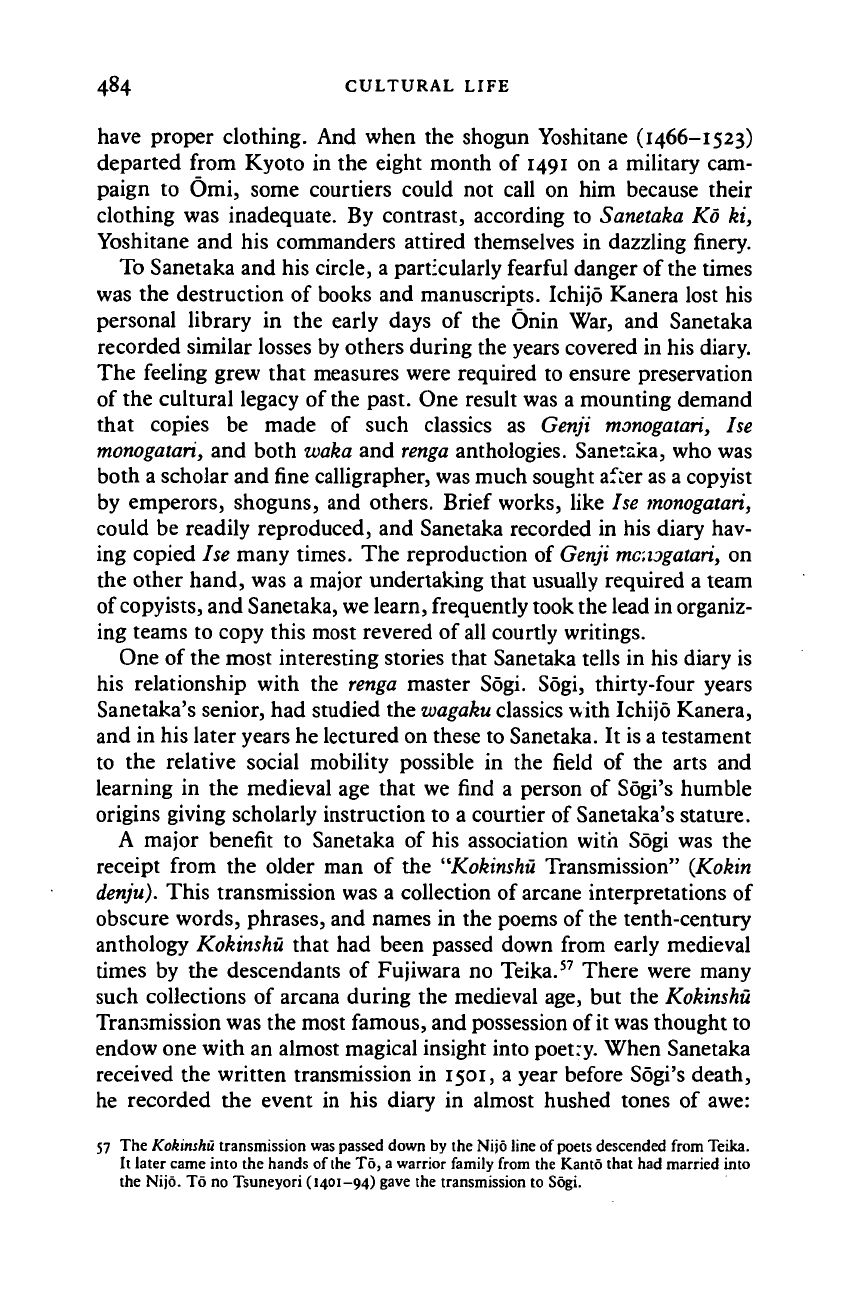
484 CULTURAL LIFE
have proper clothing. And when the shogun Yoshitane (1466-1523)
departed from Kyoto in the eight month of 1491 on a military cam-
paign to Omi, some courtiers could not call on him because their
clothing was inadequate. By contrast, according to Sanetaka Ko ki,
Yoshitane and his commanders attired themselves in dazzling finery.
To Sanetaka and his circle, a particularly fearful danger of
the
times
was the destruction of books and manuscripts. Ichijo Kanera lost his
personal library in the early days of the Onin War, and Sanetaka
recorded similar losses by others during the years covered in his diary.
The feeling grew that measures were required to ensure preservation
of the cultural legacy of the past. One result was a mounting demand
that copies be made of such classics as Genji
monogatari,
he
monogatari,
and both waka and
renga
anthologies. Sanetaka, who was
both a scholar and fine calligrapher, was much sought after as
a
copyist
by emperors, shoguns, and others. Brief works, like he
monogatari,
could be readily reproduced, and Sanetaka recorded in his diary hav-
ing copied he many times. The reproduction of
Genji
mcnogatari,
on
the other hand, was a major undertaking that usually required a team
of copyists, and Sanetaka, we learn, frequently took the lead in organiz-
ing teams to copy this most revered of all courtly writings.
One of the most interesting stories that Sanetaka tells in his diary is
his relationship with the
renga
master Sogi. Sogi, thirty-four years
Sanetaka's senior, had studied the
wagaku
classics with Ichijo Kanera,
and in his later years he lectured on these to Sanetaka. It is a testament
to the relative social mobility possible in the field of the arts and
learning in the medieval age that we find a person of Sogi's humble
origins giving scholarly instruction to a courtier of Sanetaka's stature.
A major benefit to Sanetaka of his association with Sogi was the
receipt from the older man of the "Kokinshu Transmission" (Kokin
denju).
This transmission was a collection of arcane interpretations of
obscure words, phrases, and names in the poems of the tenth-century
anthology Kokinshu that had been passed down from early medieval
times by the descendants of Fujiwara no Teika.
57
There were many
such collections of arcana during the medieval age, but the
Kokinshu
Transmission was the most famous, and possession of it was thought to
endow one with an almost magical insight into poetry. When Sanetaka
received the written transmission in 1501, a year before Sogi's death,
he recorded the event in his diary in almost hushed tones of awe:
57 The Kokinshu transmission was passed down by the Nijo line of poets descended from Teika.
It later came into the hands of
the
To, a warrior family from the Kanto that had married into
the Nijo. To no Tsuneyori (1401—94) gave the transmission to Sogi.
Cambridge Histories Online © Cambridge University Press, 2008
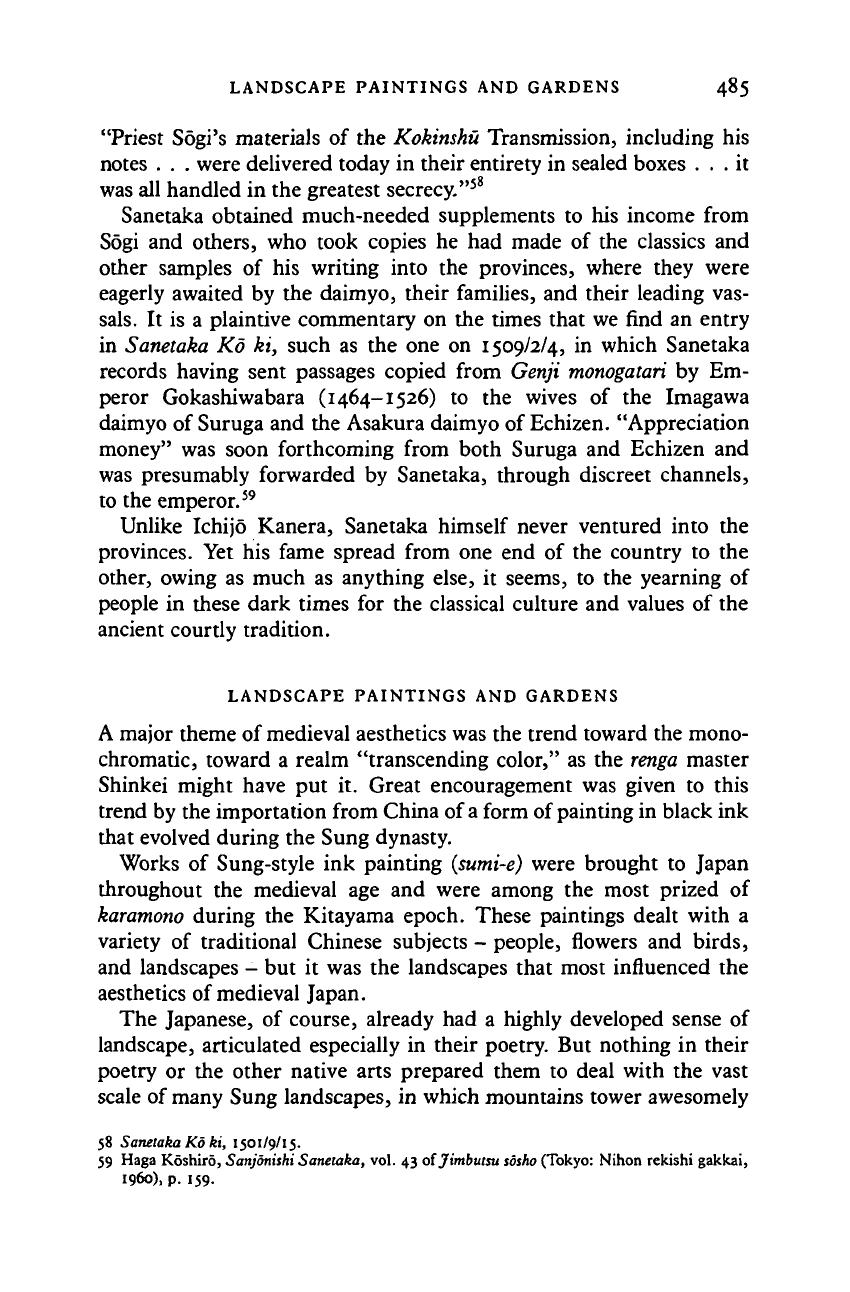
LANDSCAPE PAINTINGS AND GARDENS 485
"Priest Sogi's materials of the Kokinshu Transmission, including his
notes . . . were delivered today in their entirety in sealed boxes ... it
was all handled in the greatest secrecy."
58
Sanetaka obtained much-needed supplements to his income from
Sogi and others, who took copies he had made of the classics and
other samples of his writing into the provinces, where they were
eagerly awaited by the daimyo, their families, and their leading vas-
sals.
It is a plaintive commentary on the times that we find an entry
in Sanetaka Ko ki, such as the one on 1509/2/4, in which Sanetaka
records having sent passages copied from Genji monogatari by Em-
peror Gokashiwabara (1464-1526) to the wives of the Imagawa
daimyo of Suruga and the Asakura daimyo of Echizen. "Appreciation
money" was soon forthcoming from both Suruga and Echizen and
was presumably forwarded by Sanetaka, through discreet channels,
to the emperor.
59
Unlike Ichijo Kanera, Sanetaka himself never ventured into the
provinces. Yet his fame spread from one end of the country to the
other, owing as much as anything else, it seems, to the yearning of
people in these dark times for the classical culture and values of the
ancient courtly tradition.
LANDSCAPE PAINTINGS AND GARDENS
A major theme of medieval aesthetics was the trend toward the mono-
chromatic, toward a realm "transcending color," as the renga master
Shinkei might have put it. Great encouragement was given to this
trend by the importation from China of
a
form of painting in black ink
that evolved during the Sung dynasty.
Works of Sung-style ink painting (sumi-e) were brought to Japan
throughout the medieval age and were among the most prized of
karamono during the Kitayama epoch. These paintings dealt with a
variety of traditional Chinese subjects - people, flowers and birds,
and landscapes - but it was the landscapes that most influenced the
aesthetics of medieval Japan.
The Japanese, of course, already had a highly developed sense of
landscape, articulated especially in their poetry. But nothing in their
poetry or the other native arts prepared them to deal with the vast
scale of many Sung landscapes, in which mountains tower awesomely
58 Sanetaka Ko ki, 1501/9/15.
59 Haga Koshiro,
Sanjonishi
Sanetaka, vol. 43 of Jimbutsu
sosho
(Tokyo: Nihon rekishi gakkai,
1960),
p. 159.
Cambridge Histories Online © Cambridge University Press, 2008
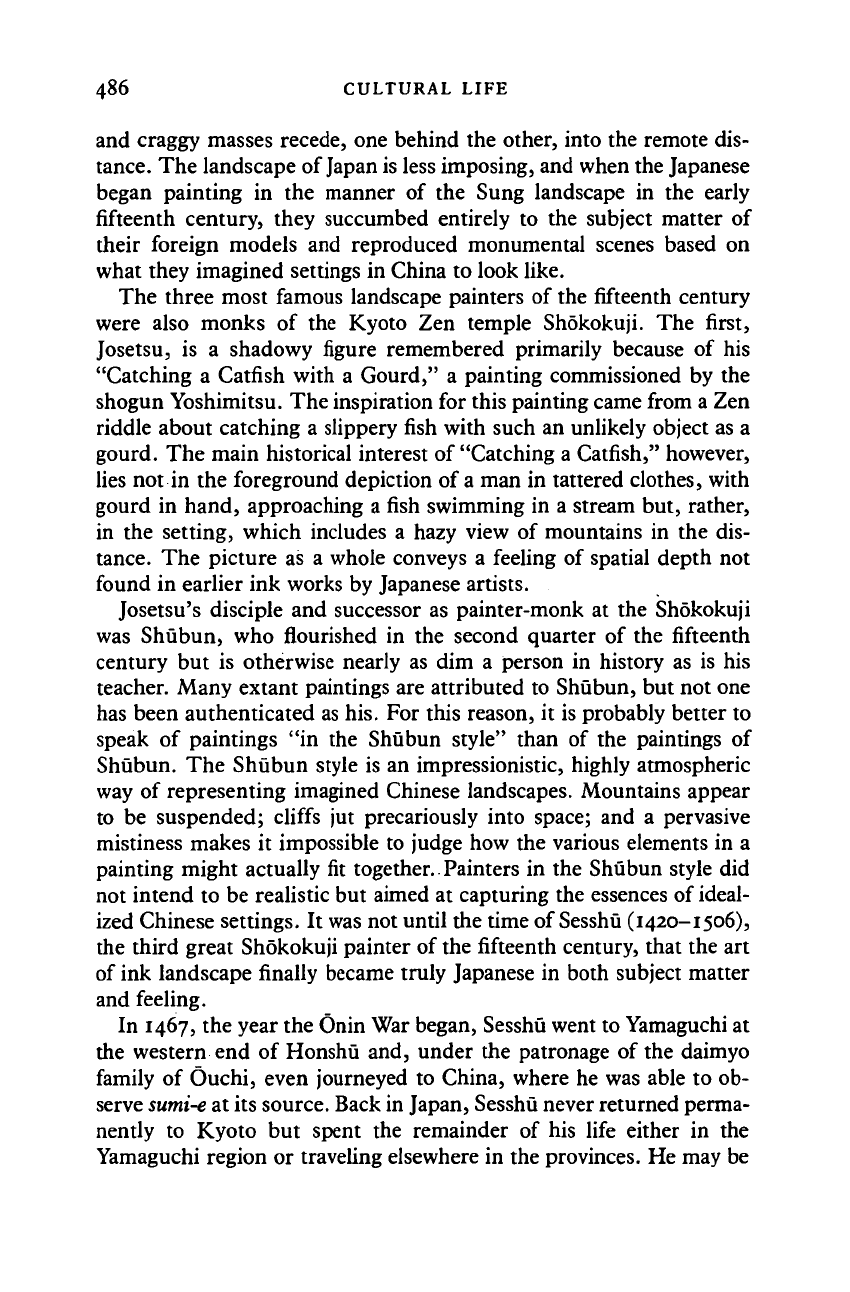
486 CULTURAL LIFE
and craggy masses recede, one behind the other, into the remote dis-
tance. The landscape of Japan is less imposing, and when the Japanese
began painting in the manner of the Sung landscape in the early
fifteenth century, they succumbed entirely to the subject matter of
their foreign models and reproduced monumental scenes based on
what they imagined settings in China to look like.
The three most famous landscape painters of the fifteenth century
were also monks of the Kyoto Zen temple Shokokuji. The first,
Josetsu, is a shadowy figure remembered primarily because of his
"Catching a Catfish with a Gourd," a painting commissioned by the
shogun Yoshimitsu. The inspiration for this painting came from a Zen
riddle about catching a slippery fish with such an unlikely object as a
gourd. The main historical interest of "Catching a Catfish," however,
lies not in the foreground depiction of
a
man in tattered clothes, with
gourd in hand, approaching a fish swimming in a stream but, rather,
in the setting, which includes a hazy view of mountains in the dis-
tance. The picture as a whole conveys a feeling of spatial depth not
found in earlier ink works by Japanese artists.
Josetsu's disciple and successor as painter-monk at the Shokokuji
was Shubun, who flourished in the second quarter of the fifteenth
century but is otherwise nearly as dim a person in history as is his
teacher. Many extant paintings are attributed to Shubun, but not one
has been authenticated as his. For this reason, it is probably better to
speak of paintings "in the Shubun style" than of the paintings of
Shubun. The Shubun style is an impressionistic, highly atmospheric
way of representing imagined Chinese landscapes. Mountains appear
to be suspended; cliffs jut precariously into space; and a pervasive
mistiness makes it impossible to judge how the various elements in a
painting might actually fit together. Painters in the Shubun style did
not intend to be realistic but aimed at capturing the essences of ideal-
ized Chinese settings. It was not until the time of Sesshu (1420-1506),
the third great Shokokuji painter of the fifteenth century, that the art
of ink landscape finally became truly Japanese in both subject matter
and feeling.
In 1467, the year the Onin War began, Sesshu went to Yamaguchi at
the western end of Honshu and, under the patronage of the daimyo
family of Ouchi, even journeyed to China, where he was able to ob-
serve
sumi-e
at its source. Back in Japan, Sesshu never returned perma-
nently to Kyoto but spent the remainder of his life either in the
Yamaguchi region or traveling elsewhere in the provinces. He may be
Cambridge Histories Online © Cambridge University Press, 2008
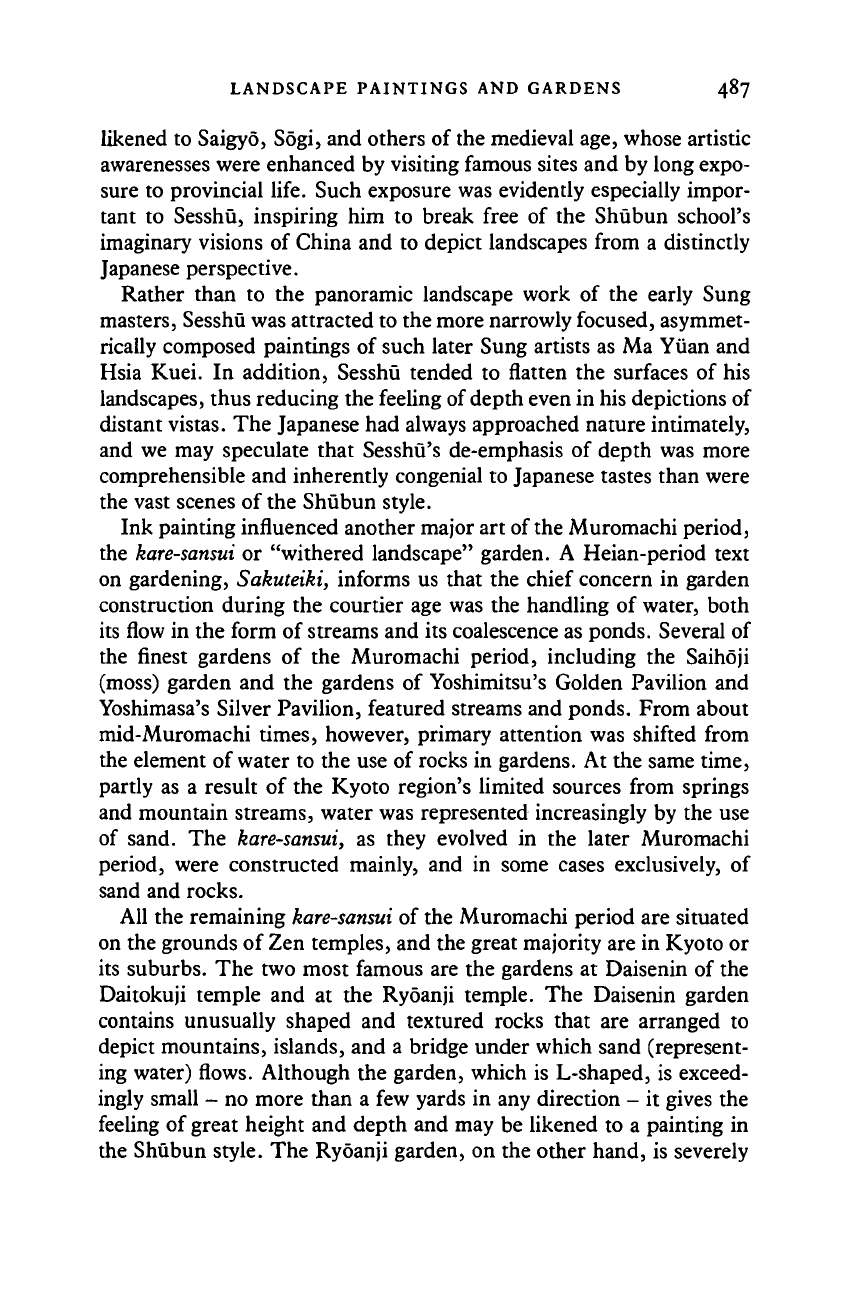
LANDSCAPE PAINTINGS AND GARDENS 487
likened to Saigyo, Sogi, and others of the medieval age, whose artistic
awarenesses were enhanced by visiting famous sites and by long expo-
sure to provincial life. Such exposure was evidently especially impor-
tant to Sesshu, inspiring him to break free of the Shubun school's
imaginary visions of China and to depict landscapes from a distinctly
Japanese perspective.
Rather than to the panoramic landscape work of the early Sung
masters, Sesshu was attracted to the more narrowly focused, asymmet-
rically composed paintings of such later Sung artists as Ma Yuan and
Hsia Kuei. In addition, Sesshu tended to flatten the surfaces of his
landscapes, thus reducing the feeling of depth even in his depictions of
distant vistas. The Japanese had always approached nature intimately,
and we may speculate that Sesshu's de-emphasis of depth was more
comprehensible and inherently congenial to Japanese tastes than were
the vast scenes of the Shubun style.
Ink painting influenced another major art of the Muromachi period,
the
kare-sansui
or "withered landscape" garden. A Heian-period text
on gardening, Sakuteiki, informs us that the chief concern in garden
construction during the courtier age was the handling of water, both
its
flow
in the form of streams and its coalescence as ponds. Several of
the finest gardens of the Muromachi period, including the Saihoji
(moss) garden and the gardens of Yoshimitsu's Golden Pavilion and
Yoshimasa's Silver Pavilion, featured streams and ponds. From about
mid-Muromachi times, however, primary attention was shifted from
the element of water to the use of rocks in gardens. At the same time,
partly as a result of the Kyoto region's limited sources from springs
and mountain streams, water was represented increasingly by the use
of sand. The
kare-sansui,
as they evolved in the later Muromachi
period, were constructed mainly, and in some cases exclusively, of
sand and rocks.
All the remaining
kare-sansui
of the Muromachi period are situated
on the grounds of Zen temples, and the great majority are in Kyoto or
its suburbs. The two most famous are the gardens at Daisenin of the
Daitokuji temple and at the Ryoanji temple. The Daisenin garden
contains unusually shaped and textured rocks that are arranged to
depict mountains, islands, and a bridge under which sand (represent-
ing water) flows. Although the garden, which is L-shaped, is exceed-
ingly small - no more than a few yards in any direction - it gives the
feeling of great height and depth and may be likened to a painting in
the Shubun style. The Ryoanji garden, on the other hand, is severely
Cambridge Histories Online © Cambridge University Press, 2008
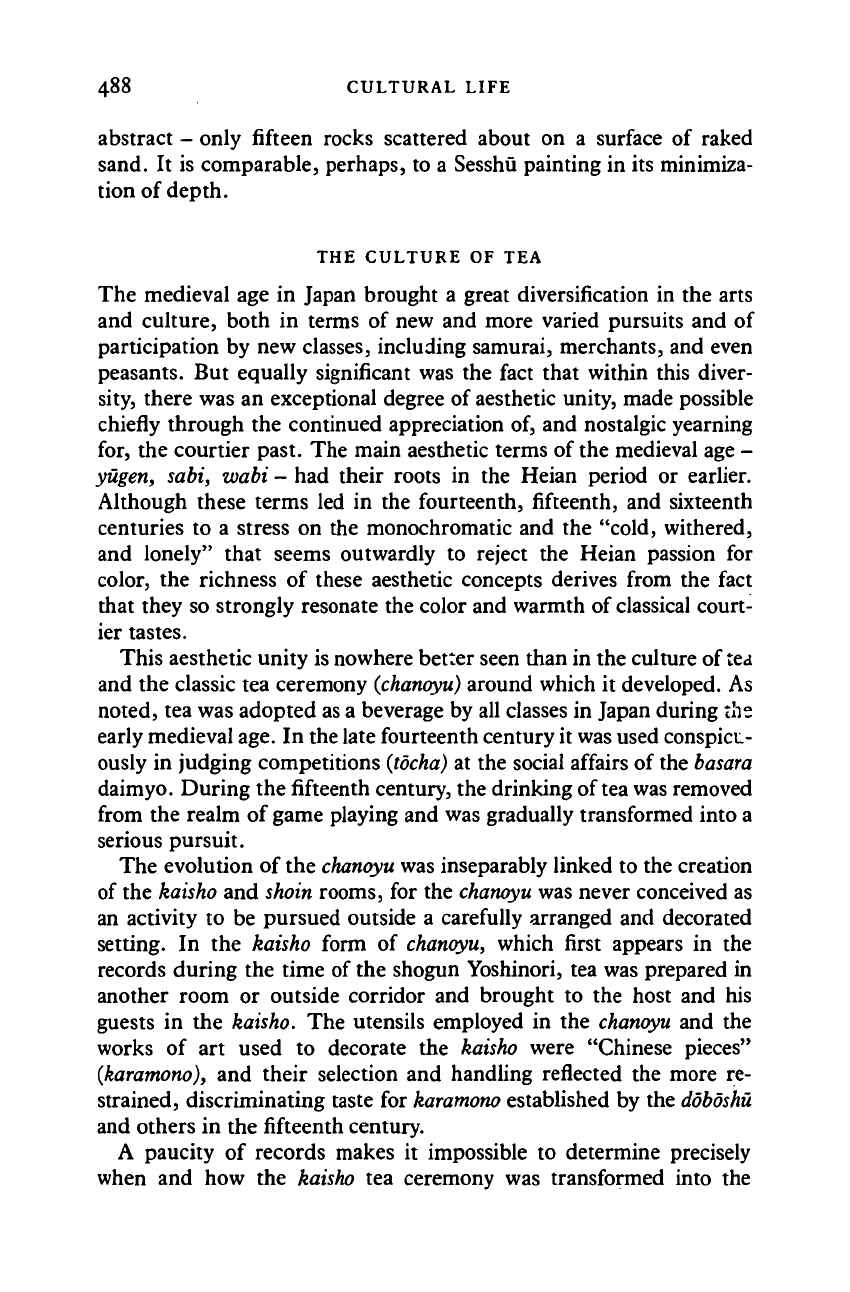
CULTURAL LIFE
abstract - only fifteen rocks scattered about on a surface of raked
sand. It is comparable, perhaps, to a Sesshu painting in its minimiza-
tion of depth.
THE CULTURE OF TEA
The medieval age in Japan brought a great diversification in the arts
and culture, both in terms of new and more varied pursuits and of
participation by new classes, including samurai, merchants, and even
peasants. But equally significant was the fact that within this diver-
sity, there was an exceptional degree of aesthetic unity, made possible
chiefly through the continued appreciation of, and nostalgic yearning
for, the courtier past. The main aesthetic terms of the medieval age -
yugen, sabi, wabi - had their roots in the Heian period or earlier.
Although these terms led in the fourteenth, fifteenth, and sixteenth
centuries to a stress on the monochromatic and the "cold, withered,
and lonely" that seems outwardly to reject the Heian passion for
color, the richness of these aesthetic concepts derives from the fact
that they so strongly resonate the color and warmth of classical court-
ier tastes.
This aesthetic unity is nowhere better seen than in the culture of tea
and the classic tea ceremony
(chanoyu)
around which it developed. As
noted, tea was adopted as a beverage by all classes in Japan during the
early medieval
age.
In the late fourteenth century it was used conspicu-
ously in judging competitions
(tocha)
at the social affairs of the
basara
daimyo. During the fifteenth century, the drinking of
tea
was removed
from the realm of game playing and was gradually transformed into a
serious pursuit.
The evolution of the
chanoyu
was inseparably linked to the creation
of the
kaisho
and
shoin
rooms, for the
chanoyu
was never conceived as
an activity to be pursued outside a carefully arranged and decorated
setting. In the kaisho form of
chanoyu,
which first appears in the
records during the time of the shogun Yoshinori, tea was prepared in
another room or outside corridor and brought to the host and his
guests in the kaisho. The utensils employed in the
chanoyu
and the
works of art used to decorate the kaisho were "Chinese pieces"
(karamono),
and their selection and handling reflected the more re-
strained, discriminating taste for
karamono
established by the
doboshu
and others in the fifteenth century.
A paucity of records makes it impossible to determine precisely
when and how the kaisho tea ceremony was transformed into the
Cambridge Histories Online © Cambridge University Press, 2008
